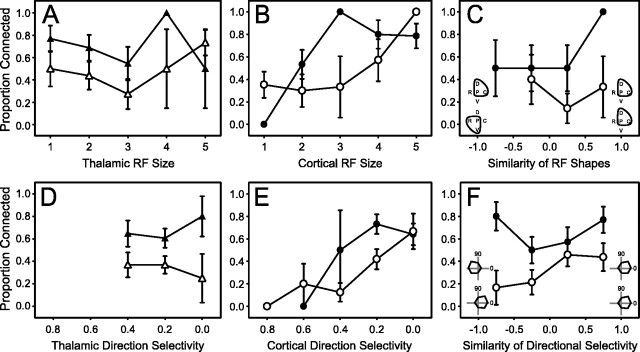Fig. 7.
RF size and direction selectivity of cortical layer IV neurons reflect the amount of nonspecific convergence of thalamocortical input. A–F, open symbols, TCU–RSU pairs; filled symbols, TCU–FSU pairs. Error bars indicate SEs of the proportion. Connected proportion of pairs as a function of A, the RF size (number of responsive whiskers) of the thalamic neuron.B, The RF size of the cortical neuron. C, The similarity of thalamic and cortical RF shapes withinsets schematically depicting examples of perfectly nonmatching (left) and matching (right) thalamic and cortical RF shapes. P, Principal whisker;C, D, R, and V, caudal, dorsal, rostral, and ventral AWs, respectively; lines, more effective whiskers. D, The directional tuning (in log units) of the response of the thalamic neuron to PW deflections.E, The directional tuning (in log units) of the responses of the cortical neuron to PW deflections. F, The similarity (see Results) of the responses of a thalamocortical pair to PW deflections in each of eight directions, withinsets schematically depicting examples of anticorrelated (left) and correlated (right) response profiles. 0, Caudal deflections; 90, dorsal deflections. D, E, Although moderately directionally selective, TCUs have a more limited range of tuning than RSUs. Likewise, tuned FSUs exist, but not in the extreme. Consequently, some datapoints do not exist for TCUs and FSUs.

